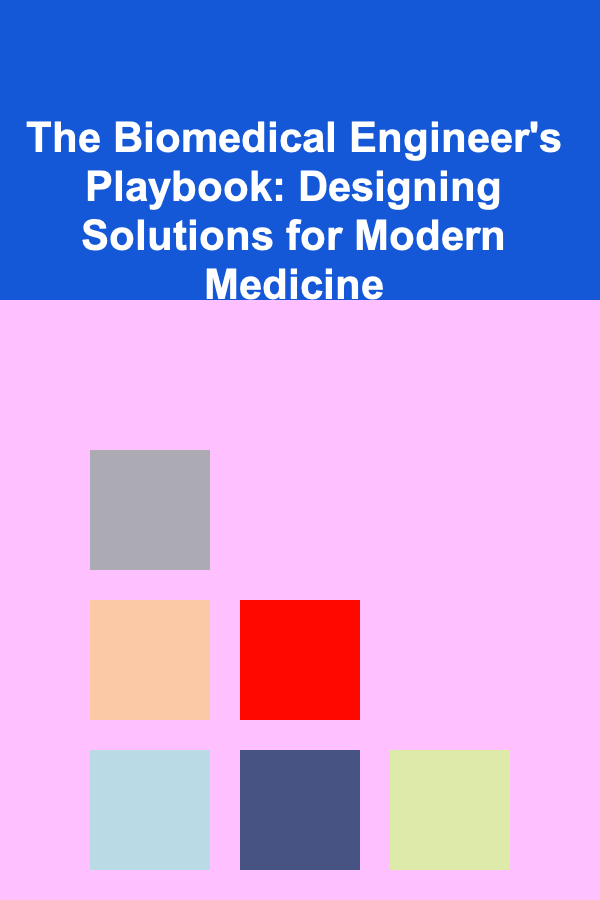
The Biomedical Engineer's Playbook: Designing Solutions for Modern Medicine
ebook include PDF & Audio bundle (Micro Guide)
$12.99$10.99
Limited Time Offer! Order within the next:

Biomedical engineering (BME) stands at the crossroads of biology, medicine, and engineering, creating innovative solutions that improve human health and quality of life. From prosthetics to diagnostic devices and cutting-edge therapeutic technologies, biomedical engineers are instrumental in transforming healthcare. The role of a biomedical engineer is vast and requires not only technical proficiency but also an understanding of human biology, a knack for creative problem-solving, and a dedication to improving patient care.
In this actionable guide, we will walk through the essential steps and considerations that biomedical engineers need to follow when designing solutions for modern medicine. From identifying healthcare needs to navigating regulatory hurdles, this playbook offers a comprehensive view of the biomedical engineering design process.
Understanding Healthcare Needs: The First Step to Innovation
The foundation of any biomedical engineering project starts with understanding the real-world challenges faced by healthcare professionals and patients. Without a clear understanding of these needs, even the most advanced technologies might fall short.
Immerse Yourself in the Clinical Environment
Before designing any solution, biomedical engineers must get involved in the clinical environment. Collaborating with healthcare professionals---doctors, nurses, therapists, and surgeons---will provide a firsthand understanding of their challenges, workflows, and pain points. Whether it's an issue with current medical devices or a gap in patient care, engineers need to be aware of the problems that need solving.
Identify Unmet Needs
The process of identifying unmet healthcare needs involves active observation and communication. Biomedical engineers should look for:
- Inefficiencies in Treatment: Devices that are difficult to use or require excessive time or effort.
- Safety Concerns: Solutions that improve the safety of patients, such as reducing human error in surgery or ensuring the accuracy of diagnostic tools.
- Access to Care: Technologies that allow for greater access to healthcare in underserved or remote areas, like telemedicine or portable diagnostic devices.
Engineers must engage directly with patients as well. Listening to patients' frustrations with existing technologies can often provide valuable insights into design improvements.
Understand Medical Trends
Keeping up with the latest medical research, health trends, and emerging diseases is equally important. With the increasing prevalence of chronic diseases like diabetes and cardiovascular issues, the demand for solutions that address long-term care is growing. Likewise, understanding demographic trends, such as the aging population, will guide engineers in developing solutions tailored to specific groups.
The Design Process: Transforming Ideas into Tangible Solutions
Once the healthcare need has been identified, the next step is to begin conceptualizing potential solutions. This phase of the process is where engineering principles come into play, merging creativity and technical expertise.
Conceptualization and Ideation
The initial stages of design involve brainstorming and considering various potential solutions. Some critical aspects to focus on include:
- User-Centered Design: The goal is to create devices that are not only effective but also easy to use. This requires considering the abilities and limitations of healthcare providers and patients. A device that is too complicated or cumbersome can deter its use.
- Feasibility Studies: An idea must be tested for technical viability. This includes evaluating the required materials, the complexity of the design, and whether the technology can be manufactured at scale.
Material Selection and Biocompatibility
Biomedical devices often come into direct contact with human tissue, meaning that the materials used must be biocompatible. This requires a deep understanding of materials science and biology. Whether using metals, polymers, ceramics, or composite materials, the engineer must ensure that:
- Materials are Non-toxic: The device should not elicit a negative immune response or cause tissue damage.
- Long-Term Durability: Many medical devices must function for years, so engineers must ensure that the materials used can withstand wear and tear.
- Mechanical Compatibility: For implants, prosthetics, or any device that interacts with the body, engineers must consider how it affects human biomechanics.
Collaboration and Cross-Disciplinary Teamwork
The design process benefits from interdisciplinary collaboration. Biomedical engineers often work with a variety of specialists to ensure their designs are effective. For example:
- Collaboration with Medical Experts: Continuous input from clinicians helps ensure that designs are practical and effective in real-world medical environments.
- Integration with Technology Experts: Many modern biomedical devices integrate AI, robotics, or advanced sensors. Engineers may need to collaborate with software developers or data scientists to incorporate these features effectively.
Prototyping and Testing: From Concept to Reality
After an initial design is created, engineers must develop a working prototype. Prototyping is essential in translating theoretical ideas into tangible products. It allows engineers to test their designs in real-world conditions and identify areas for improvement.
Rapid Prototyping
The ability to create prototypes quickly has been revolutionized by advancements in technologies like 3D printing and additive manufacturing. Biomedical engineers can now produce prototypes more efficiently, which accelerates the iteration process. This enables:
- Testing Multiple Iterations: Engineers can quickly test several design variations to determine which one works best.
- Improving Design Based on Feedback: Prototyping allows engineers to gather feedback from medical professionals and patients, improving the device's usability and effectiveness.
Preclinical and Clinical Testing
Once a prototype is developed, it undergoes testing. The two major stages in testing are:
- Preclinical Testing: This is the first stage of testing, often performed using animal models. It helps to assess the safety and performance of the device.
- Clinical Trials: After preclinical testing, the device is tested on humans through clinical trials. These trials are essential to ensure that the device is safe, effective, and practical for widespread use.
Both types of testing require adherence to strict ethical guidelines and regulatory protocols.
Navigating Regulatory Pathways: Ensuring Safety and Compliance
Before a biomedical device can be introduced to the market, it must meet the approval of regulatory bodies such as the U.S. Food and Drug Administration (FDA) , the European Medicines Agency (EMA), or other national regulatory bodies. These organizations ensure that medical devices are safe and effective for use.
Understanding the Classification of Medical Devices
Regulatory bodies classify medical devices based on the level of risk they pose to patients:
- Class I Devices: Low-risk devices, such as bandages or simple diagnostic tools.
- Class II Devices: Moderate-risk devices, such as infusion pumps or surgical instruments.
- Class III Devices: High-risk devices, such as pacemakers or implantable devices.
The regulatory pathway depends on the device classification. More high-risk devices require more rigorous testing and approval processes.
Documentation and Quality Control
Engineers must provide comprehensive documentation to demonstrate that their device meets safety and performance standards. This documentation includes:
- Design Specifications: Detailed information on how the device is designed, manufactured, and tested.
- Clinical Data: Results from clinical trials showing the device's safety and efficacy.
- Post-Market Surveillance: A plan to monitor the device's performance once it is released to ensure ongoing safety and effectiveness.
Bringing Innovations to Market: Manufacturing and Adoption
After a device receives regulatory approval, it must be manufactured, distributed, and adopted by healthcare providers. This is where the engineering process transitions from development to real-world application.
Manufacturing and Scalability
Scaling up production while maintaining high standards of quality is essential. Biomedical engineers must work closely with manufacturers to ensure that the production process remains cost-effective, efficient, and compliant with medical standards. Factors to consider include:
- Material Sourcing: Sourcing high-quality, biocompatible materials at scale.
- Quality Assurance: Ensuring each device is manufactured according to strict quality control standards.
- Cost Control: Designing for manufacturability while keeping production costs within acceptable limits.
Training and Integration
Once devices are manufactured, healthcare providers need training to use them effectively. Biomedical engineers may be involved in:
- Training Programs: Creating instructional materials or conducting workshops to ensure proper use.
- Customer Support: Providing ongoing support to address any issues or make improvements based on feedback.
The Lasting Impact of Biomedical Engineering
Biomedical engineering is about more than just creating devices. It's about making a real difference in people's lives by improving healthcare systems and patient outcomes. Whether designing life-saving equipment, enhancing diagnostic capabilities, or developing innovative therapies, biomedical engineers play a critical role in modern medicine.
By staying focused on human-centered design, fostering interdisciplinary collaboration, and maintaining rigorous standards, biomedical engineers ensure that their contributions not only meet medical needs but also drive the future of healthcare innovation. In doing so, they shape the future of medicine, improving lives and advancing the field to new heights.
Reading More From Our Other Websites
- [Beachcombing Tip 101] How to Identify and Collect Vintage Bottle Caps While Beachcombing on the Gulf Coast
- [Home Family Activity 101] How to Organize a Family DIY Spa Day at Home
- [Personal Investment 101] How to Stay Informed About Market Trends and News
- [Organization Tip 101] The Best Farmhouse Kitchen Sink Styles for Your Home
- [Home Family Activity 101] How to Organize a Family Charity Event at Home
- [Mindful Eating Tip 101] From Kitchen to Classroom: How Online Mindful Eating Workshops Transform Your Relationship with Food
- [Home Space Saving 101] How to Build a Custom Built-In Bookshelf with Integrated Magazine Storage
- [Home Rental Property 101] How to Handle Rent Collection and Payment Methods Efficiently
- [Metal Stamping Tip 101] From Design to Flight: The End‑to‑End Workflow of Aerospace Metal Stamping
- [Personal Finance Management 101] How to Tackle Student Loan Debt While Maintaining a Balanced Life

How to Declutter Your Digital Devices for Better Focus
Read More
How to Stage Outdoor Spaces to Boost Your Home's Curb Appeal
Read More
Mindful Shopping: Cutting Down on Impulse Online Purchases
Read More
How To Pair Wine with Pizza
Read More
How to Master Split Pushing in MOBAs
Read More
How to Initiate Conversations That Lead Somewhere
Read MoreOther Products

How to Declutter Your Digital Devices for Better Focus
Read More
How to Stage Outdoor Spaces to Boost Your Home's Curb Appeal
Read More
Mindful Shopping: Cutting Down on Impulse Online Purchases
Read More
How To Pair Wine with Pizza
Read More
How to Master Split Pushing in MOBAs
Read More